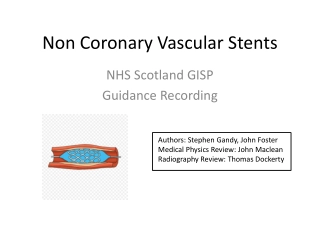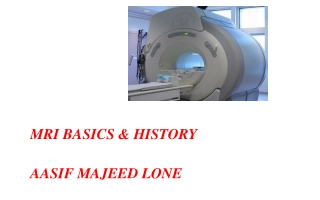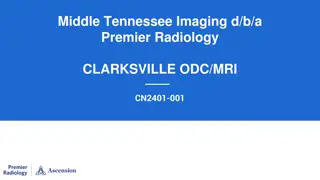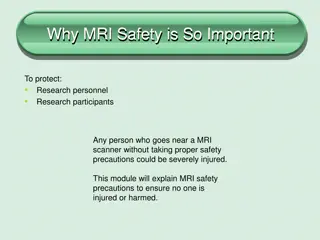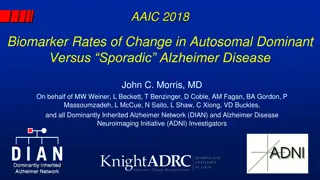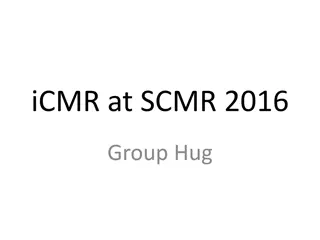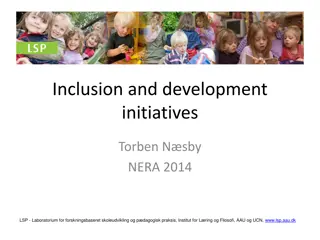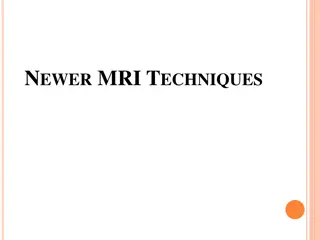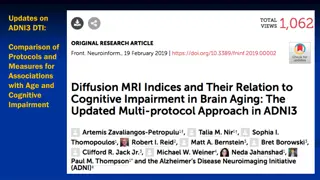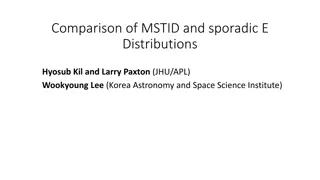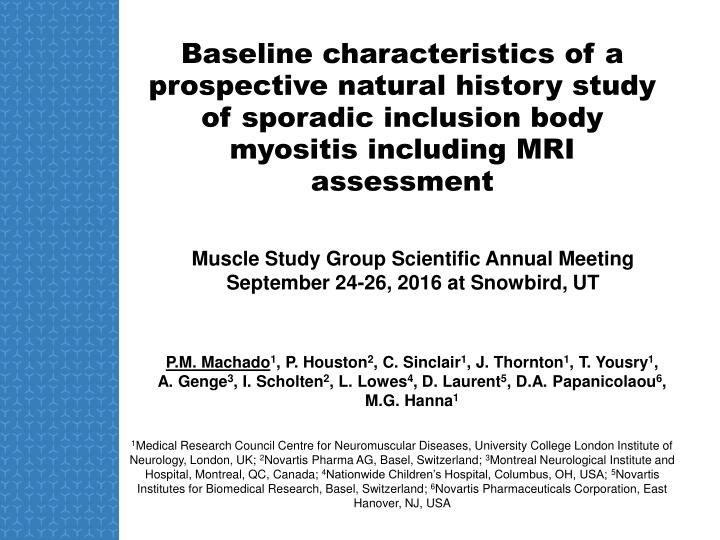
Prospective Study of Sporadic Inclusion Body Myositis with MRI Assessment
Explore the baseline characteristics of a prospective natural history study on sporadic inclusion body myositis, focusing on MRI assessment. The study aims to track the clinical progression and functional impact of sIBM over time using the sIBM Physical Functioning Assessment and thigh muscle MRI. This longitudinal study involves patients from multiple countries and aims to provide valuable insights into this rare degenerative disorder associated with aging.
Download Presentation

Please find below an Image/Link to download the presentation.
The content on the website is provided AS IS for your information and personal use only. It may not be sold, licensed, or shared on other websites without obtaining consent from the author. If you encounter any issues during the download, it is possible that the publisher has removed the file from their server.
You are allowed to download the files provided on this website for personal or commercial use, subject to the condition that they are used lawfully. All files are the property of their respective owners.
The content on the website is provided AS IS for your information and personal use only. It may not be sold, licensed, or shared on other websites without obtaining consent from the author.
E N D
Presentation Transcript
Baseline characteristics of a prospective natural history study of sporadic inclusion body myositis including MRI assessment Muscle Study Group Scientific Annual Meeting September 24-26, 2016 at Snowbird, UT P.M. Machado1, P. Houston2, C. Sinclair1, J. Thornton1, T. Yousry1, A. Genge3, I. Scholten2, L. Lowes4, D. Laurent5, D.A. Papanicolaou6, M.G. Hanna1 1Medical Research Council Centre for Neuromuscular Diseases, University College London Institute of Neurology, London, UK; 2Novartis Pharma AG, Basel, Switzerland; 3Montreal Neurological Institute and Hospital, Montreal, QC, Canada; 4Nationwide Children s Hospital, Columbus, OH, USA; 5Novartis Institutes for Biomedical Research, Basel, Switzerland; 6Novartis Pharmaceuticals Corporation, East Hanover, NJ, USA
Disclosures Pedro M. Machado and Michael G. Hanna serve as consultants to Novartis and declare research support from MRC Centre grant award. Linda Lowes serves as a consultant to PTC, Sarepta, and Bristol Meyer Squib. There was no payment from Novartis for participation in this study. Her institution has received grant support for clinical trials from Novartis. John Thornton received research support from MRC Centre grant award. Parul Houston, Ingo Scholten, Didier Laurent, and Dimitris A. Papanicolaou are employees of Novartis and may be eligible for Novartis stock and stock options. Angela Genge was employed with Novartis from January 2014 to July 2014. The data has been previously presented as a poster at the 2nd Congress of European Academy of Neurology; May 28 31, 2016, Copenhagen, Denmark. 2
Introduction Sporadic inclusion body myositis (sIBM) is a rare, debilitating degenerative and inflammatory disorder associated with aging. Characterized by progressive weakness and atrophy of proximal and distal muscles.1,2,3 There are limited data that longitudinally characterize the functional impairment, patient burden and economic impact of sIBM. The sIBM Physical Functioning Assessment (sIFA) is a newly developed patient-reported outcome that measures physical function. 11 questions that assess the impact of sIBM on upper and lower extremity function as well as dysphagia.4 1. Cortese A. et al. Neuromuscul Disord. 2013;23:404-12; 2.Cox FM, et al. Brain. 2011;134:3167 75; 3. Benveniste O, et al. Brain. 2011;134:3176 84; 4. Williams V, et al. Muscle Nerve. 2016 [Epub ahead of print]. 3
Objectives To characterize the clinical progression and functional impact of sIBM over time, as measured by sIFA. To assess thigh muscle composition using MRI. MRI, magnetic resonance imaging; sIBM, sporadic inclusion body myositis; sIFA, sIBM Physical Functioning Assessment 4
Study design and participants This is a longitudinal, natural history study in patients with sIBM across sites in Canada, Sweden, UK and the US. As of November 30, 2015 (data cut-off date), a total of 184 patients had been recruited. Inclusion criteria patients aged 45 years. diagnosis of sIBM.1,2 patients willing and able to complete the patient questionnaires and the functional assessments. Patients with concurrent diagnosis of any other neurologic or neuromuscular disease that affected the same muscle groups as sIBM were not included in the study. sIBM, sporadic inclusion body myositis 1. Hilton-Jones D, et al. Neuromuscul Disord. 2010;20:142 7; 2. Rose MR, ENMC IBM Working Group. Neuromuscul Disord. 2013; 23:1044 55. 5
Assessments The following data were collected at baseline sIFA total score. Quadriceps quantitative muscle testing (QMT). Hand-grip dynamometry. 6-minute walking distance (6MWD). Physician assessment of disease severity. Thigh Muscle Volume (TMV) and the corresponding Inter/Intramuscular Adipose Tissue (IMAT) volume was assessed by MRI in a subset of 19 patients. PD- and T1-weighted images, 1.5T Siemens Avanto sIFA, sIBM Physical Functioning Assessment 6
Statistical analysis Correlations were made between the sIFA patient-reported outcome and assessments of mobility/strength (6MWD and quadriceps QMT) in a subset of 137 patients. Correlations between sIFA and objective assessments of muscle composition measured using MRI were analyzed in a subset of 19 patients. A non-parametric Spearman correlation coefficient was calculated for the correlation analyses. 6MWD, 6-minute walking distance; sIFA, sIBM physical functioning assessment; QMT, quadriceps quantitative muscle testing 7
Demographics and baseline characteristics of the study population Ethnicity Caucasian, n (%) Asian, n (%) Other, n (%) Black, n (%) 176 (96.2) 3 (1.6) 3 (1.6) 1 (0.5) 132 (72.1) Gender, male, n (%) 68.2 (7.9) Age (years), mean (SD) 9.8 (5.7) Time since symptom onset to baseline visit (years), mean (SD)a 4.8 (4.6) Time since symptom onset to diagnosis (years), mean (SD)b 172 (94.0) Ambulatory patients, n (%) 13 (7.1) Prior medication prescribed for sIBM, n (%) 142 (77.2) Any comorbid conditions, n (%) 5.5 (4.0) Number of comorbid conditions, mean (SD) Enrolled population, N=184; cut-off date: November 30, 2015 aEnrollment year minus year of first symptoms; bYear of diagnosis minus year of first symptoms Ambulatory was defined as patients who are not wheelchair bound and the 6-MWD was at least 1 meter (intermittent use of wheelchair or scooter is allowed. However, the patient must not be aided by a person when performing the walk test but may use a gait aid device) 6-MWD, 6-minute walking distance; n, number of patients in population; SD, standard deviation; sIBM, sporadic inclusion body myositis 8
Disease characteristics 62 (33.9) Patients with falls in the month prior to enrollment, n (%) Fall consequences in the 12 months prior to enrollment Hospitalization, n (%) Fractures, n (%) Healthcare visits, n (%) 5 (2.7) 10 (5.5) 43 (23.5) Walking aids Inside or around the home, n (%) Outside the home, n (%) 70 (38.3) 117 (63.9) 324.7 (139.9) 6-MWD (m), mean (SD)a 46.2 (23.3) sIFA total score, mean (SD)b Disease severity assessed by physician Mild, n (%) Moderate, n (%) Severe, n (%) Very severe, n (%) 65 (35.5) 88 (48.1) 27 (14.8) 3 (1.6) aData available for 172 of 184 enrolled patients. bNormalized score ranged from 0 (no difficulty) to 100 (highest difficulty). Cut-off date: November 30, 2015 6-MWD, 6-minute walking distance; n, number of patients in population; SD, standard deviation; sIBM, sporadic inclusion body myositis 9
Results Association between sIFA total score and physician assessment of severity. Severe Physician rating of sIBM symptoms Moderate Mild 0 20 40 60 80 100 sIFA total score Countries Canada No difficulty Highest difficulty UK US Sweden Data available for 137 of 184 enrolled patients; Cut-off date: July 31, 2015. sIBM, sporadic inclusion body myositis; sIFA, sIBM physical functioning assessment 10
Results Correlation between sIFA total score and 6-MWD. 700 R=-0.79 Total distance walked (m) 600 500 400 300 200 100 0 0 20 40 60 80 100 sIFA total score Countries Canada R=Spearman correlation coefficient No difficulty Highest difficulty UK US Sweden Data available for 137 of 184 enrolled patients; Cut-off date: July 31, 2015. 6-MWD, 6-minute walking distance; sIFA, sIBM physical functioning assessment 11
Results Correlation between sIFA total score and QMT quadriceps. R=-0.66 60 QMT quadriceps (Kg) 50 40 30 20 10 0 0 20 40 60 80 100 sIFA lower body functioning score Countries Canada R=Spearman correlation coefficient No difficulty Highest difficulty UK US Sweden Data available for 137 of 184 enrolled patients; Cut-off date: July 31, 2015. 6-MWD, 6-minute walking distance; sIFA, sIBM physical functioning assessment 12
Results Correlation between MRI relative IMAT and sIFA total score. 100 R=0.35 80 sIFA total score 60 40 20 0 0 20 40 60 80 100 Relative IMAT (%) Countries Canada R=Spearman correlation coefficient No difficulty Highest difficulty UK US Sweden Note: MRI correlations with sIFA were available from 19 patients; MRI was performed using a 1.5T Siemens Avanto scanner and a proton- density weighted pulse sequence; Cut-off date: July 31, 2015. IMAT, inter/intramuscular adipose tissue; relative IMAT=IMAT volume x 100/(TMV+IMAT+SAT); MRI, magnetic resonance imaging; SAT; subcutaneous adipose tissue; sIFA, sIBM physical functioning assessment 13
Results Correlation between MRI relative TMV and sIFA total score. 100 R=-0.63 80 sIFA total score 60 40 20 0 0 20 40 60 80 100 Relative TMV (%) Countries Canada R=Spearman correlation coefficient No difficulty Highest difficulty UK US Sweden Note: MRI correlations with sIFA were available from 19 patients; MRI was performed using a 1.5T Siemens Avanto scanner and a proton- density weighted pulse sequence; Cut-off date: July 31, 2015. IMAT, inter/intramuscular adipose tissue; MRI, magnetic resonance imaging; SAT, subcutaneous adipose tissue; sIFA, sIBM physical functioning assessment; TMV, thigh muscle volume; relative TMV=TMV x 100/(TMV+IMAT+SAT) 14
Conclusions Significant functional impairment in patients with sIBM was observed in this study. This study demonstrated significant correlations of sIFA with clinical outcomes as well as objective assessments of muscle composition as assessed by MRI. This study provided data about the validity of MRI muscle composition as an outcome measure in sIBM. Findings from this study will help to determine clinical progression, functional impact, and the disease burden of sIBM over time. MRI, magnetic resonance imaging; sIFA, sIBM physical functioning assessment; sIBM, sporadic inclusion body myositis 15
Acknowledgements Authors sincerely thank the principal investigators and support staff at the all centers of this study, and the patients enrolled in this study. Authors would also like to acknowledge Preetinder Kaur from Novartis Healthcare Pvt. Ltd. for medical writing support. 16

